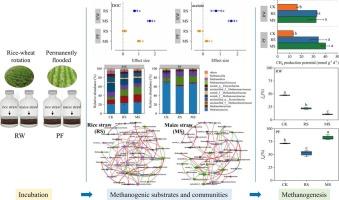两种水稻土中秸秆通过不同产甲烷途径产生甲烷的研究
IF 5
2区 农林科学
Q1 SOIL SCIENCE
引用次数: 0
摘要
秸秆还田为水稻土提供了大量的碳源,促进了CH4的产生和排放。然而,秸秆类型(水稻和玉米,对应C3和C4植物)对产甲烷途径和微生物机制的影响尚不清楚。本研究以稻麦轮作土壤(RW)和永久淹水土壤(PF)两种水稻土为研究对象,在稻麦秸秆(RS)和玉米秸秆(MS)的条件下进行厌氧培养,研究秸秆对产甲烷途径和古菌群落的影响。结果表明,添加MS后生成的CH4的δ 13ch4值分别为- 39.22‰~ - 44.99‰和- 48.31‰~ - 53.19‰。此外,与未添加秸秆相比,添加秸秆可提高RW土壤CH4生产潜力95% ~ 100%,PF土壤CH4生产潜力161% ~ 207% (13.1 ~ 16.6 μ CH4 g−1 d−1)。在RW土壤中,这种刺激可能与秸秆增加氢营养化产甲烷有关。事实上,氢营养化产甲烷对总CH4产量(1 - fac)的贡献从对照(CK)的55%增加到添加RS的75%,添加MS的85%。同时,产氢甲烷菌的相对丰度分别从10%增加到20% (RS)和25% (MS)。秸秆添加显著增加了RW土壤的乙酸消耗,表明乙酸可能先转化为CO2/H2,然后再转化为CH4,而不是直接转化为CH4。在PF土壤中,添加RS显著增加CH4产量也可能与1 - face和氢营养型甲烷杆菌的增加有关。相反,添加MS主要促进了丙酮酸产甲烷以刺激CH4的产生,其面值从70%增加到80%,丙酮酸产甲烷的相对丰度从60%增加到70%。研究结果表明,秸秆类型导致的产甲烷菌和碳同位素的差异是影响不同水稻土产甲烷途径的关键因素,并为研究不同水稻土秸秆添加条件下的产甲烷机制提供了有价值的见解。本文章由计算机程序翻译,如有差异,请以英文原文为准。

Straw-mediated CH4 production via distinct methanogenic pathways in two paddy soils
Straw returning provides large carbon sources to paddy soils, stimulating CH4 production and emissions. However, the effects of straw types (rice and maize, corresponding to C3 and C4 plants) on the methanogenic pathway and microbial mechanisms are still unknown. Here, two paddy soils [rice-wheat rotation soil (RW) and permanently flooded soil (PF)] were anaerobically incubated with rice straw (RS) and maize straw (MS) additions to investigate the response of methanogenic pathways and archaeal communities to straw addition. Our results showed that the produced CH4 with MS addition was significantly enriched in 13C than that of others, with δ13CH4-values ranging from −39.22 ‰ to −44.99 ‰ and − 48.31 ‰ to −53.19 ‰, respectively. Moreover, CH4 production potential was increased by 95 %–100 % in RW soil and 161 %–207 % in PF soil with straw addition, compared with no straw addition (13.1–16.6 μg CH4 g−1 d−1). This stimulation in RW soil was probably associated with the increase in hydrogenotrophic methanogenesis by straw addition. Indeed, the contribution of hydrogenotrophic methanogenesis to total CH4 production (1– fac) increased from 55 % in control (CK) to 75 % in RS addition, and to 85 % in MS addition. Meanwhile, the relative abundance of hydrogenotrophic Methanobacterium increased from 10 % to 20 % (RS) and 25 % (MS), respectively. Straw addition significantly increased acetate consumption in RW soil, indicating that acetate might first transfer to CO2/H2 and then to CH4 rather than directly to CH4. For PF soil, the significant increase in CH4 production by RS addition was also likely ascribed to the rise of 1– fac and hydrogenotrophic Methanobacterium. In contrast, MS addition mainly promoted acetoclastic methanogenesis to stimulate CH4 production, with fac-values increased from 70 % to 80 % and relative abundance of acetoclastic Methanosarcina increased from 60 % to 70 %. The findings show that the differences in methanogens and carbon isotopic caused by straw types are key factors affecting methanogenic pathways, and further provide valuable insights into the methanogenic mechanisms under straw addition in different paddy soils.
求助全文
通过发布文献求助,成功后即可免费获取论文全文。
去求助
来源期刊

Applied Soil Ecology
农林科学-土壤科学
CiteScore
9.70
自引率
4.20%
发文量
363
审稿时长
5.3 months
期刊介绍:
Applied Soil Ecology addresses the role of soil organisms and their interactions in relation to: sustainability and productivity, nutrient cycling and other soil processes, the maintenance of soil functions, the impact of human activities on soil ecosystems and bio(techno)logical control of soil-inhabiting pests, diseases and weeds.
 求助内容:
求助内容: 应助结果提醒方式:
应助结果提醒方式:


